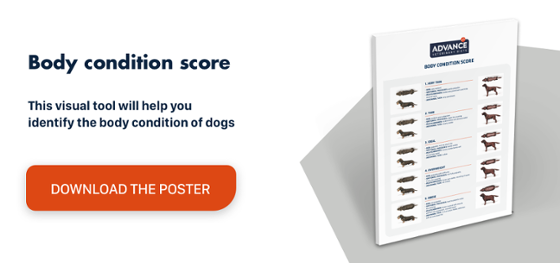Exocrine pancreatic insufficiency in dogs
After pancreatitis, exocrine pancreatic insufficiency, or EPI, is the second-most common disease of the exocrine pancreas in cats and dogs.
EPI is the result of insufficient production and secretion of pancreatic digestive enzymes and other substances, usually caused by a dysfunction of the pancreatic acinar cells, which leads to nutrient malabsorption, poor digestion and eventually malnutrition.1,2
Pathophysiology
It is thought that EPI develops when more than 90% of the pancreatic parenchyma is destroyed and the remaining functional portion is incapable of producing and secreting enough:1
- Enzymes, to digest proteins, fats and carbohydrates (protease, lipase and amylase).
- Bicarbonate, to neutralise gastric acid.
- Pancreatic intrinsic factor, to allow cobalamin absorption.
- Antimicrobial proteins, to regulate the intestinal microbiota.
The pancreas’ endocrine function is usually unaffected.1,3
EPI has multiple consequences:1,2,4
- The most significant is poor intraluminal digestion of dietary nutrients, due to the lack of intraluminal enzyme activity, in other words, the absence of amylase, lipase and protease.
- Changes in the intestinal microbiota, usually leading to dysbiosis. This is due to the lack of pancreatic antimicrobial proteins and poorly digested food in the intestinal lumen.
- Secondary changes to intestinal mucosa function and its microanatomy, such as villous atrophy and inflammatory cell infiltration, due to the deficit of trophic factors in the mucosa, regulatory peptides and intrinsic factors.
- Lesions in the intestinal mucosa caused by an abnormally acidic pH.
- Possible biochemical changes, including to amino acid metabolism and DNA synthesis, as a result of cobalamin malabsorption.
- Less frequently, and particularly characteristic of dogs with EPI in the absence of pancreatic acinar atrophy (PAA), is the alteration of glucose homeostasis due to the islets of Langerhans deficiency, which can trigger diabetes.
Aetiology
The most common cause of EPI in dogs is PAA. However, there are other, far less common aetiologies, such as chronic pancreatitis (CP), pancreatic hypoplasia and pancreatic neoplasms.1,2,5
Dogs of all breeds can develop EPI. However, different studies have shown greater genetic susceptibility among German Shepherds, accounting for about 40–60% of all cases in Europe and North America. To a lesser extent, other breeds also have a predisposition to EPI, including the Rough Collie, Eurasier and Cavalier King Charles Spaniel.1,2
The onset of EPI has been reported across a wide age range. Nonetheless, dogs that develop EPI secondary to PAA are usually young animals (up to 4 years), while those with CP tend to be middle-aged or senior dogs. This also relates to the genetic predisposition in the breeds mentioned above, given that PAA is a more common heritability factor among German Shepherds and Rough Collies. No notable differences have been observed regarding a predisposition in either sex.1,2,4
Clinical signs
The clinical signs of exocrine pancreatic insufficiency tend to be easily recognisable, but they are not considered pathognomonic because other intestinal diseases may show similar signs of malabsorption. Indeed, the differential diagnosis of EPI almost always includes other disease processes that affect the small intestine and also cause malabsorption and/or poor digestion.3,5
The most common signs – in 90% of dogs affected by EPI – are:
- Loss of weight and muscle mass.
- Increased or normal appetite.
- Grey or yellowish, semi-formed stools.
- Steatorrhoea.
- Increased stool volume and defecation frequency.
- Flatulence and bowel sounds.
- Dry, unhealthy coat.
Other signs have been reported, including anorexia, absence of diarrhoea, pasty diarrhoea, vomiting, occasional coprophagy or pica, aggressiveness, nervousness and even dermatological problems. Polydipsia and polyuria may be observed in patients with diabetes.
Some cases of EPI course without any clinical signs because the disease develops subclinically and can only be diagnosed by laboratory tests.1–4
Diagnosis and complementary tests
The diagnosis is initially based on findings in the patient’s medical history and on the presenting clinical signs. It is subsequently confirmed by complementary tests on pancreatic structure, function and pathology.1
The differential diagnosis should include, among other diseases, primary or secondary causes of chronic diarrhoea of the small intestine, disorders associated with weight loss (diabetes, liver failure, etc.), intestinal parasitosis, inflammatory bowel diseases, lymphangiectasia and small intestine neoplasms.2,4
The blood count, blood chemistry profile and urinalysis results are usually irrelevant in the diagnosis of EPI, as are serum lipase and amylase activity tests.1
Pancreatic function tests are currently used to diagnose exocrine pancreatic insufficiency, as they distinguish whether the dog’s clinical signs are due to EPI or a problem in the small intestine.2,3 The laboratory test of choice is serum canine trypsin-like immunoreactivity (cTLI), a species-specific test that quantifies trypsinogen and trypsin blood levels. It provides an indirect assessment of functional exocrine pancreatic tissue without interference from other intestinal disorders.1,3,4
In dogs:1,4
- cTLI values < 2.5 ng/mL confirm the diagnosis of EPI.
- Values of 2.5–5.7 ng/mL are considered inconclusive, and the test should be repeated in 1 or 2 weeks.
Another possible test is a faecal chemotrypsin and pancreatic elastase-1 determination. The monoclonal antibody ELISA technique determines the level of the elastase-1 in faeces.1–4
Complementary tests such as serum cobalamin and folate can rule out or confirm small intestine bacterial overgrowth.
A morphological and histopathological study of the pancreas can also be performed when the underlying cause of the onset of EPI is still undiagnosed.1
Treatment
- Supplementation with digestive pancreatic enzymes at each meal. There are several products on the market with different formulations: capsules and powders with or without enteric coatings and raw pancreas.
- Cobalamin vitamin supplementation, where necessary.
- Nutritionally, dietary changes are not usually required, provided that special attention is paid to the patient’s individual needs. Nevertheless, a low-fibre, moderate-fat diet has often been shown to be beneficial.
Other dugs, such as antibiotics and antacids, can be considered on a case-by-case basis.1–5

